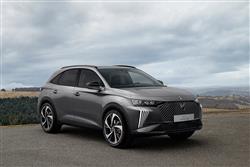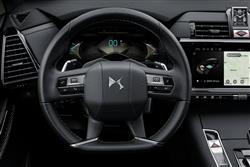DS 7 E-TENSE 4x4 300 - ABC Leasing
How will you view?
This is a sample, showing 30 seconds of each section.
A PERFECT TENSE?(some text hidden)
By Jonathan Crouch
Ten Second Review word count: 72
The DS 7 E-TENSE 4x4 300 represents this luxury French brand's more distinctive take on what a 'D'-segment luxury plug-in SUV should be. It can take you up to 42 miles without emitting any CO2, theoretically manage 250mpg, sprint to sixty in under six seconds and even extricate you from a muddy carpark on your annual trip to Glastonbury. In short, it's a bit special - and is styled that way too.
Background word count: 188
Looking at the various electrified alternatives the current car-buying customer now has on offer, it's sometimes hard not to think that the plug-in hybrid option is arguably the best. Mild hybrid tech doesn't make much difference to overall efficiency figures. And full-electric models still carry the scourge of 'range anxiety'. So being able to plug in to extend the range of a conventional petrol engine with a lithium-ion battery charge makes as much sense now as it did when we first saw plug-in models hit the market, nearly a decade ago. When it comes to SUVs, you'll generally need a mid-sized or larger one to be able to specify plug-in technology. The Stellantis Group makes a number of the various 'C'-segment SUVs that offer it - cars like hybrid versions of the Peugeot 3008, the Citroen C5 Aircross and the Vauxhall Grandland. Plus the French conglomerate has also used the same tech for a slightly larger, more luxurious model that sits in the 'D'-segment just above - this car, the DS 7 E-TENSE 4x4, which we're looking at here in mid-range '300' form, a car now usefully improved.
Driving Experience word count: 279
Unlike the DS brand's smaller electrified model, the DS 3 E-TENSE, this car isn't a full-electric SUV. Instead, a 200hp 1.6-litre petrol turbo engine beats beneath the bonnet, its efforts now boosted by a larger 14.2kWh battery that in the '300' version powers an accompanying pair of 109hp electric motors which together boost total power output up to 300hp. That equates to a useful 450Nm of torque, which is transmitted to the tarmac via an eight-speed auto gearbox. 62mph from rest occupies 5.9s. When fully charged, this car can cover up to 42 WLTP-rated miles in zero emission form, though you won't go anywhere like that far if you explore the possibility for an 83mph all-electric top speed. There are four drive modes available. 'Electric' is the default setting, which sees functioning only using its electric motors. More commonly, you'll be running in 'Hybrid mode', which sees the electric motors and the engine efficiently working together. If you're pressing on, you'll use 'Sport' mode, which is engine-only. This is a 4x4 model and if you're off piste, you can make the most of that by engaging a '4WD' setting which activates the rear axle for all-wheel drive. So how does it all work in practice? Well as you might expect, the extra weight of all this electrified kit (around 400kgs) is certainly noticeable once you start pushing along a bit through the corners. But this is really only significantly evident once you start driving the car in a manner that few likely owners never will. Better to throttle back and enjoy the superb ride comfort and refinement and the relaxed, loping refined demeanour that suits this Gallic contender best.
Pictures (High res disabled)

.jpg)
.jpg)
.jpg)
.jpg)
.jpg)
.jpg)

Scoring
Category: Compact Car
| Performance | |
| Handling | |
| Comfort | |
| Space | |
| Styling | |
| Build | |
| Value | |
| Equipment | |
| Economy | 90% |
| Depreciation | 50% |
| Insurance | 70% |
| Total | 72% |